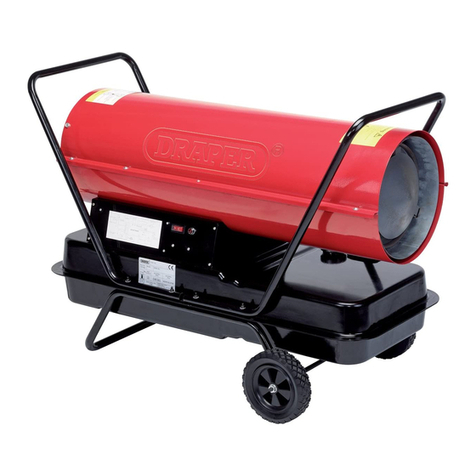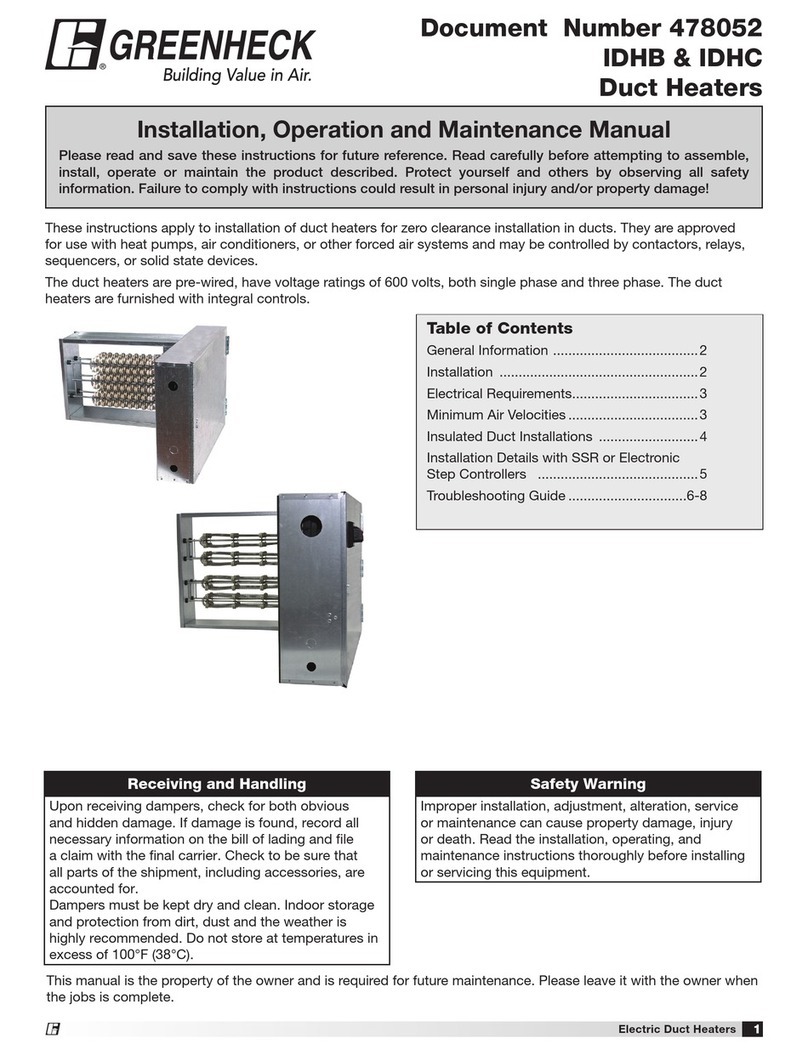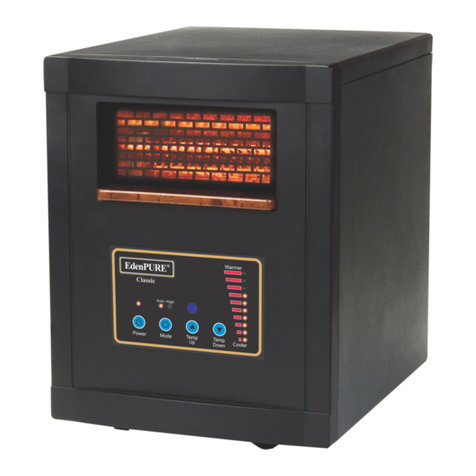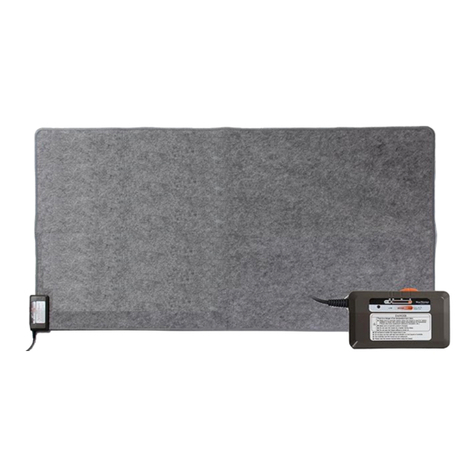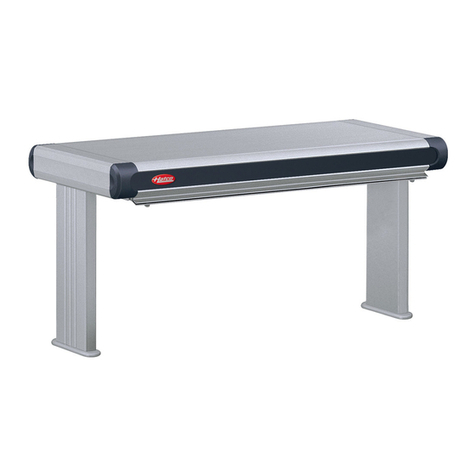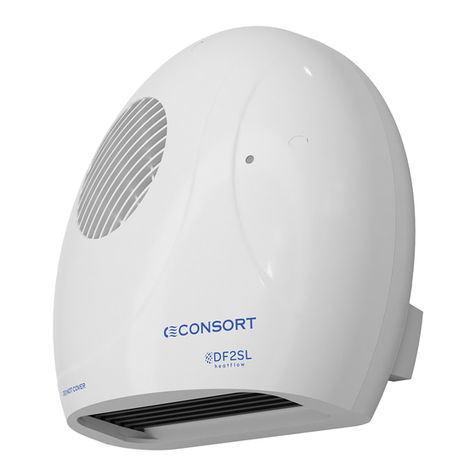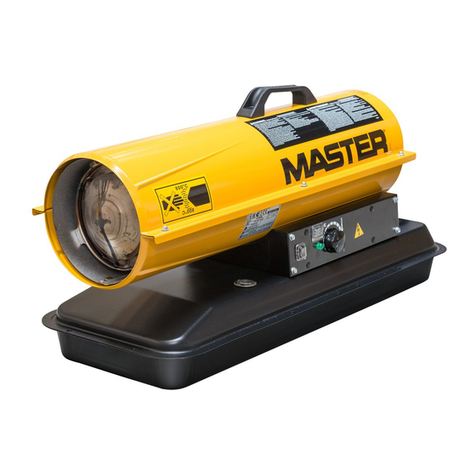Robur Next-R Service manual

Installation, use and maintenance manual
Next-R
Powered by natural gas/LPG
Gas unit heaters for use in industrial and commercial
installations

This Installation, use and maintenance manual has been drawn up and printed by Robur S.p.A.; whole or partial
reproduction of this Installation, use and maintenance manual is prohibited.
The original is led at Robur S.p.A.
Any use of this Installation, use and maintenance manual other than for personal consultation must be previously
authorised by Robur S.p.A.
The rights of those who have legitimately led the registered trademarks contained within this publication are not
aected.
With the aim of continuously improving the quality of its products, Robur S.p.A. reserves the right to modify the
data and contents of this Installation, use and maintenance manual without prior notice.
Revision: E
Code: D-LBR851
DISPOSAL
The appliance and all its accessories must be disposed of separately in accordance with the regulations in force.
Use of the WEEE symbol (Waste Electrical and Electronic Equipment) indicates that this product cannot be disposed of as household waste.
Proper disposal of this product helps to prevent potential negative consequences for the environment and human health.

Installation, use and maintenance manual – Next-R 3
INDEX OF CONTENTS
I Introduction.............................................................................
p.4
I.1 Recipients ..........................................................................
p.4
I.2 Control device..................................................................
p.4
II Symbols and denitions...............................................
p.4
II.1 Key to symbols.................................................................
p.4
II.2 Terms and denitions....................................................
p.4
III Warnings......................................................................................
p.4
III.1 General and safety warnings......................................
p.4
III.2 Conformity ........................................................................
p.5
III.3 Exclusions of liability and warranty..........................
p.6
1 Features and technical data......................................
p.7
1.1 Features..............................................................................
p.7
1.2 Dimensions .......................................................................
p.8
1.3 Components...................................................................
p.13
1.4 Electrical wiring diagram ...........................................
p.15
1.5 Operation mode............................................................
p.17
1.6 Controls ............................................................................
p.17
1.7 Technical characteristics.............................................
p.18
2 Transport and positioning........................................
p.20
2.1 Warnings..........................................................................
p.20
2.2 Handling...........................................................................
p.20
2.3 Appliance positioning.................................................
p.20
2.4 Minimum clearance distances..................................
p.21
2.5 Support bracket.............................................................
p.22
3 Heating engineer...............................................................
p.22
3.1 Warnings..........................................................................
p.22
3.2 Fuel gas supply ..............................................................
p.23
3.3 Combustion products exhaust ................................
p.23
3.4 Air ducting.......................................................................
p.28
4 Electrical installer..............................................................
p.29
4.1 Warnings..........................................................................
p.29
4.2 Electrical systems..........................................................
p.29
4.3 Electrical power supply...............................................
p.29
4.4 Control system...............................................................
p.29
5 First start-up ..........................................................................
p.34
5.1 Preliminary checks........................................................
p.34
5.2 Combustion parameters check................................
p.35
5.3 Gas changeover.............................................................
p.38
6 Normal operation..............................................................
p.40
6.1 Warnings..........................................................................
p.40
6.2 Switch on and o..........................................................
p.40
6.3 Eciency..........................................................................
p.42
6.4 Restarting a locked-down unit.................................
p.42
7 Maintenance..........................................................................
p.43
7.1 Warnings..........................................................................
p.43
7.2 Scheduled routine maintenance.............................
p.43
7.3 Resetting the temperature limit thermostat.......
p.43
7.4 Troubleshooting............................................................
p.43
7.5 Periods of inactivity......................................................
p.44
8 Appendices..............................................................................
p.45
8.1 Product che...................................................................
p.45

Introduction
4
I
IINTRODUCTION
Manual
This Manual is an integral part of the Next-R unit and
must be handed to the end user together with the
appliance.
I.1 RECIPIENTS
This Manual is intended for:
▶
End user, for appropriate and safe use of the appliance.
▶
Qualied installer, for correct appliance installation.
▶
Planner, for specic information on the appliance.
I.2 CONTROL DEVICE
In order to work, the Next-R unit requires a control device to be
connected by the installer (see Paragraph 1.6
p.17
).
II SYMBOLS AND DEFINITIONS
II.1 KEY TO SYMBOLS
DANGER
WARNING
NOTE
PROCEDURE
REFERENCE (to other document)
II.2 TERMS AND DEFINITIONS
Appliance / Unit = equivalent terms, both used to refer to the
gas unit heater.
TAC = Technical Assistance Centre authorised by Robur.
External request = generic control device (e.g. thermostat, tim-
er or any other system) equipped with a voltage-free NO contact
and used as control to start/stop the unit.
OCDS012 1-key basic control = control device that signals the
ame lock-out and allows its resetting.
OCTR000 2-key basic control = control device that signals
the ame lock-out and allows its resetting and also allows se-
lecting winter operation (space heating) or summer operation
(ventilation).
OTRG005 thermoregulator = control device that allows to
manage settings and operation of one Next-R gas unit heater.
OCDS008 digital chronothermostat = device that integrates
the functions of room temperature control and remote control
of one or more Next-R gas unit heaters, when connected to the
OTRG005 thermoregulator.
OSWR000 Genius software for remote management = soft-
ware that allows, through the OTRG005 termoregulators, to cen-
tralize the management of up to 100 Next-R gas unit heaters.
First start-up = appliance commissioning operation which may
only and exclusively be carried out by a TAC.
III WARNINGS
III.1 GENERAL AND SAFETY WARNINGS
Installer's qualications
Installation must exclusively be performed by a quali-
ed rm and by skilled personnel, with specic knowl-
edge on heating, electrical systems and gas appliances,
in compliance with the laws in force in the Country of
installation.
Declaration of conformity
Upon completing installation, the installing rm shall
issue to the owner/client the appliance's workmanlike
conformity declaration, according to national/local reg-
ulations in force and the manufacturer's instructions/
provisions.
Misuse
The appliance must only be used for the purposes for
which it has been designed. Any other use is deemed
hazardous. Incorrect use may aect operation, duration
and safety of the appliance. Adhere to the manufactur-
er's instructions.
Use of the appliance by children
The device can be used by children over 8 years old,
and by people with reduced physical, sensory or mental
capabilities, or lack of experience or knowledge, only if
they are under surveillance or after they have received
instructions regarding safe use of the appliance and un-
derstanding the dangers inherent in it. Children should
not play with the appliance. Cleaning and maintenance
that must be performed by the user must not be per-
formed by unsupervised children.
Hazardous situations
Do not start the appliance in hazardous conditions, such
as: gas smell, problems with the electrical/gas system,
parts of the appliance under water or damaged, mal-
functioning, disabling or bypassing control and safety
devices.
In case of danger, request intervention by qualied

Warnings
Installation, use and maintenance manual – Next-R 5
III
personnel.
In case of danger, switch othe electrical power and gas
supplies only if this can be done in total safety.
Do not entrust children, persons with physical, sensory
or mental disabilities or persons with poor knowledge
and experience with use of the appliance.
Gas component tightness
Before performing any operation on gas ducting compo-
nents, close the gas valve.
Upon completing any procedure, perform the tightness
test according to regulations in force.
Gas smell
If you smell gas:
Do not use electrical devices such as telephones, mul-
timeters or other equipment that may cause sparks next
to the appliance.
Shut othe gas supply by turning the valve o.
Open immediately doors and windows to create a
cross-current of air to purify the room.
Disconnect electrical power supply by means of the
external isolation switch in the power supply electrical
panel.
Use a telephone away from the appliance to ask for inter-
vention from qualied personnel.
Poisoning
Ensure the ue gas ducts are tightness and compliant
with the regulations in force.
Upon completing any procedure, ensure components
are tightness.
Moving parts
The appliance contains moving parts.
Do not remove guards during operation, and in any case
prior to disconnecting the power supply.
Burn hazard
The appliance contains very hot parts.
Do not open the appliance and do not touch internal
components before the appliance has cooled down.
Do not touch the ue gas exhaust before it has cooled
down.
Electrocution hazard
Disconnect the electrical power supply before any oper-
ation on appliance components.
For electrical connections exclusively use compliant
components and according to the specications provid-
ed by the manufacturer.
Ensure the appliance cannot be accidentally switched
back on.
Earthing
Electrical safety depends on eective earthing system,
correctly connected to the appliance and installed ac-
cording to the regulations in force.
Air ow
Do not obstruct the fan intake or the hot air outlet.
Distance from combustible or ammable materials
Do not deposit ammable materials (paper, diluents,
paints, etc.) near the appliance.
Comply with current regulations.
Aggressive substances in the air
The air of the installation site must be free from aggres-
sive substances.
Acid ue gas condensate
Discharge the acid condensate of combustion ue gas,
as indicated in Paragraph 3.3
p.23
, in compliance with
current exhaust regulations.
Switching the appliance o
Disconnecting the power supply while the appliance
is running may cause permanent damage to internal
components.
Except in the event of danger, do not disconnect the
power supply to switch othe appliance, but always and
exclusively act through the provided control device.
In the event of failure
Operations on internal components and repairs may
exclusively be carried out by a TAC, using only original
parts.
In the event of failure of the appliance and/or breakage
of any component, do not attempt to repair and/or re-
store and immediately contact the TAC.
Routine maintenance
Proper maintenance assures the eciency and good op-
eration of the appliance over time.
Maintenance must be performed according to the man-
ufacturer's instructions (see Chapter 7
p.43
) and in
compliance with current regulations.
Appliance maintenance and repairs may only be entrust-
ed to rms legally authorised to work on gas appliances
and systems.
Enter into a maintenance contract with an authorised
specialised rm for routine maintenance and for servic-
ing in case of need.
Use only original parts.
Keep the Manual
This Installation, use and maintenance manual must al-
ways accompany the appliance and must be handed to
the new owner or installer in the event of sale or removal.
III.2 CONFORMITY
EU Directives and standards
The Next-R series gas unit heaters are certied in accordance
with European regulation GAR 426/2016/EU and meet the es-
sential requirements of the following Directives:

Warnings
6
III
▶
2016/426/EU "Gas Appliances Regulation" as amended and
added.
▶
2014/30/EC "Electromagnetic Compatibility Directive" as
amended and added.
▶
2014/35/EC "LowVoltage Directive" as amended and added.
▶
2006/42/EC "Machine Directive" as amended and added.
▶
2281/2016/EU "Ecodesign requirements for air heating prod-
ucts" as amended and added.
Furthermore, they comply with the requirements of the follow-
ing standards:
▶
EN 1020 Non-domestic forced convection gas-red air heat-
ers for space heating not exceeding a net heat input of 300
kW incorporating a fan to assist transportation of combus-
tion air or combustion products.
▶
prEN 17082 Domestic and non-domestic gas-red forced
convection air heaters for space heating not exceeding a net
heat input of 300 kW.
Other applicable provisions and standards
The design, installation, operation and maintenance of the sys-
tems shall be carried out in compliance with current applicable
regulations, depending on the Country and location, and in ac-
cordance with the manufacturer's instructions. In particular, reg-
ulations regarding the following shall be complied with:
▶
Gas systems and equipment.
▶
Electrical systems and equipment.
▶
Heating systems.
▶
Environmental protection and combustion products ex-
haust.
▶
Fire safety and prevention.
▶
Any other applicable law, standard and regulation.
III.3 EXCLUSIONS OF LIABILITY AND
WARRANTY
Any contractual or extra-contractual liability of the man-
ufacturer for any damage caused by incorrect installa-
tion and/or improper use and/or failure to comply with
regulations and with the manufacturer's directions/in-
structions shall be disclaimed.
In particular, the warranty on the appliance may be ren-
dered void by the following conditions:
Incorrect installation.
Misuse.
Failure to comply with the manufacturer's indications on
installation, use and maintenance.
Alteration or modication of the product or any part
thereof.
Extreme operational conditions or however outside of
the operational ranges set forth by the manufacturer.
Damages caused by external agents such as salts, chlo-
rine, sulphur or other chemical substances present in the
air of the installation site.
Abnormal actions transmitted to the appliance by the
plant or installation (mechanical stresses, pressure, vi-
brations, thermal expansion, electrical surges...).
Accidental damages or due to force majeure.

Features and technical data
Installation, use and maintenance manual – Next-R 7
1
1FEATURES AND TECHNICAL DATA
1.1 FEATURES
1.1.1 Available range
Next-R gas unit heaters are available in three versions:
▶
with horizontal ow, with axial fan (Next-R series)
▶
with horizontal ow, ductables, with centrifugal fan (Next-R
C series)
▶
with vertical downow (Next-R V series)
Choosing the correct ow direction
Due to characteristics and positioning of internal com-
ponents, Next-R V vertical downow gas unit heaters
cannot be used for horizontal ow operation, and vice
versa, horizontal ow gas unit heaters cannot under any
circumstances be used for vertical downow operation.
1.1.2 Operation
The Next-R series gas unit heater is an independent heating ap-
pliance with airtight combustion circuit and forced air draft.
It has been designed to be installed inside the room to be
heated.
The combustion circuit is room sealed and meets the require-
ments for type C appliances: combustion air supply and ue gas
exhaust discharge take place outdoors and are ensured by the
functioning of a blower inserted in the combustion circuit.
The appliance is also approved for type B for installations where
it is allowed to take the combustion air directly from the room
to be heated.
The operation of the gas unit heater is controlled by a control
device (not supplied).
The gas unit heater can operate on two burner power levels,
with constant fan speed.
Products of gas combustion (natural gas or LPG) ow internally
through the heat exchangers, which are invested externally by
the air current produced by the fan, delivering hot air ow into
the room.
The fan operates automatically only when it receives the ena-
bling signal, depending on the model, from the fan thermostat
or by the electronic board timer, i.e. with hot heat exchangers, in
order to avoid the introduction of cold air into the room, and it
will switch owith cold exchangers.
The air ow direction is adjustable vertically by means of the re-
volving louvres of the grille.
If heat exchangers overheat due to malfunction, a temperature
limit thermostat cuts othe supply to the gas valve, thus inter-
rupting fuel ow and turning othe burner.
A blower upline of the burner mixes the air and gas and expels
the combustion fumes.
In the event of obstructions in the intake or exhaust duct, or in
the event of malfunction of the blower, the gas valve stops, thus
also interrupting the ow of fuel to the burner.
In summer it is possible to operate the fan only in order to pro-
vide a pleasant air ow within the room.
1.1.3 Mechanical components
▶
Pre-mix stainless steel burner.
▶
High head blower.
▶
Control board for brushless motor of the blower.
▶
Cylindrical stainless steel combustion chamber.
▶
Corrugated stainless steel heat exchangers with very large
exchange surface (R15, R20 models).
▶
Robur patented heat exchangers, made out of a special al-
uminium die-cast alloy, with horizontal nning on the air
side and vertical nning on the ue gas exhaust side, with
a very high heat exchange capacity (R30, R40, R50, R60, R80
models).
▶
External steel panelling with epoxy powder enamel nish.
▶
Axial fan(s) with high ow rate.
▶
Centrifugal fan (for the Next-R C series).
1.1.4 Control and safety devices
▶
100 °C limit thermostat with manual reset against heat ex-
changers overheating.
▶
Dierential pressure switch for controlling the correct opera-
tion of the blower (all models except R15, R20).
▶
Fan thermostat (for R30, R40, R50, R60, R80 models).
▶
Ventilation timer (for R15, R20 models).
▶
Gas solenoid valve.
▶
Controller for ignition, adjustment and ame control.

Features and technical data
8
1
1.2 DIMENSIONS
1.2.1 Axial gas unit heaters
1.2.1.1 R15/R20
Figure1.1Unit dimensions
1 Flue gas exhaust
2 Combustion air inlet
3 Power supply cables input
4 Gas connection 3/4" M
5 Thermoformed door
6 Limit thermostat
7 Flue gas exhaust blind cover, alternative to
the rear one (1)
(*) Holes for xing to the support bracket
557
419
480
225
678
485
445
138
320
233
252
80
80
397
403
247
12
3
4
6
5
7
400 (*)
176 (*)
1.2.1.2 R30
Figure1.2Unit dimensions
1 Flue gas exhaust
2 Combustion air inlet
3 Power supply cables input
4 Gas connection 3/4" M
5 Thermoformed door
6 Limit thermostat
(*) Holes for xing to the support bracket
731
777
435
593
734
515
475
210
475
257257
80
80
12
3
4
383
340
690
370 (*)
405 (*)
6
5

Features and technical data
Installation, use and maintenance manual – Next-R 9
1
1.2.1.3 R40
Figure1.3Unit dimensions
1 Flue gas exhaust
2 Combustion air inlet
3 Power supply cables input
4 Gas connection 3/4" M
5 Thermoformed door
6 Limit thermostat
(*) Holes for xing to the support bracket
731
777
435
593
734
515
475
210
475
257257
80
80
12
3
4
400
340
690
370 (*)
405 (*)
6
5
1.2.1.4 R50
Figure1.4Unit dimensions
1 Flue gas exhaust
2 Combustion air inlet
3 Power supply cables input
4 Gas connection 3/4" M
5 Thermoformed door
6 Limit thermostat
(*) Holes for xing to the support bracket
746
593
435
777
928
709
669
210
475
354354
80
80
12
3
4
690
340
519
620 (*)
405 (*)
6
5

Features and technical data
10
1
1.2.1.5 R60
Figure1.5Unit dimensions
1 Flue gas exhaust
2 Combustion air inlet
3 Power supply cables input
4 Gas connection 3/4" F
5 Thermoformed door
6 Limit thermostat
(*) Holes for xing to the support bracket
731
593
435
777
1119
900
860
210
475
80
80
340
690
383
3
4
12 432 234234
810 (*)
405 (*)
6
5
1.2.1.6 R80
Figure1.6Unit dimensions
1 Flue gas exhaust
2 Combustion air inlet
3 Power supply cables input
4 Gas connection 3/4" F
5 Thermoformed door
6 Limit thermostat
(*) Holes for xing to the support bracket
746
593
435
777
1319
1100
1060
80
80
519
340
690
12
3
4
475
210
540 282280
1010 (*)
405 (*)
6
5

Features and technical data
Installation, use and maintenance manual – Next-R 11
1
1.2.2 Centrifugal gas unit heaters
1.2.2.1 R30 C
Figure1.7Unit dimensions
1 Flue gas exhaust
2 Combustion air inlet
3 Power supply cables input
4 Gas connection 3/4" M
5 Thermoformed door
6 Limit thermostat
(*) Holes for xing to the support bracket
734
777
774
601
431
40
580
157
469
260
260
595
482
528
40
5
80
80
12
3
4
6
690
340
389
298
510
1031
601
176
389
212
462
243
405 (*) 370 (*)
1.2.2.2 R40 C
Figure1.8Unit dimensions
1 Flue gas exhaust
2 Combustion air inlet
3 Power supply cables input
4 Gas connection 3/4" M
5 Thermoformed door
6 Limit thermostat
(*) Holes for xing to the support bracket
734
777
774
601
472
157
580
40
469
260
260
40
595
528
482
1072
601
460
134
446
197
80
80
12
3
4
6
690
340
446
333
550
5
278
405 (*) 370 (*)

Features and technical data
12
1
1.2.2.3 R50 C
Figure1.9Unit dimensions
1 Flue gas exhaust
2 Combustion air inlet
3 Power supply cables input
4 Gas connection 3/4" M
5 Thermoformed door
6 Limit thermostat
(*) Holes for xing to the support bracket
928
777
601
537
968
580 469
260
260
40
789
722
676
5
85
521
172
1138
601
460
311
538
521
690
340
315
80
80
12
3
4
6
405 (*) 620 (*)
1.2.2.4 R80 C
Figure1.10Unit dimensions
1 Flue gas exhaust
2 Combustion air inlet
3 Power supply cables input
4 Gas connection 3/4" F
5 Thermoformed door
6 Limit thermostat
(*) Holes for xing to the support bracket
131940
1180
1113
1067
777
580
157
40
469
260
260
1359
601
472
1113
108 333 230 333 108
446
278
12
3
4
6
5
80
80
340
690
446
197
134
461
601
1072
1010 (*)
405 (*)
1.2.3 Vertical downow gas unit heaters
The dimensions of the vertical downow gas unit heaters are
identical to those of the corresponding axial models (Paragraph
1.2.1
p.8
).
Figure 1.11
p.13
below details the centre distances between
the vertical suspension brackets for the dierent models of

Features and technical data
Installation, use and maintenance manual – Next-R 13
1
vertical downow gas unit heaters.
Figure1.11Position of vertical downow gas unit heaters brackets
1 Vertical suspension brackets
A Upper brackets centre distance
B Lower brackets centre distance
785
A
B
1 1
Table1.1Centre distance of the vertical suspension brackets
Model A B
R30 V 494 370
R40 V 494 370
R50 V 688 620
1.3 COMPONENTS
1.3.1 R15/R20
Figure1.12Internal components
1 Electrical panel
2 Controller for ignition, adjustment and ame
control
3 Terminal block
4 Gas valve
5 Limit thermostat
6 Ignition transformer
7 Combustion blower
8 Flame sensor / ignition electrodes
1
3
4
5
6
78
2

Features and technical data
14
1
1.3.2 R30/R40/R50/R60/R80
Figure1.13Internal components
1 Electrical panel
2 Controller for ignition, adjustment and ame
control
3 Terminal block
4 Gas valve
5 Limit thermostat
6 Ignition transformer
7 Combustion blower
8 Flame sensor / ignition electrodes
9 Dierential pressure switch
1 93
4
5
6
7
8
2

Features and technical data
Installation, use and maintenance manual – Next-R 15
1
1.4 ELECTRICAL WIRING DIAGRAM
1.4.1 R15/R20
Figure1.14Electrical wiring diagram
CV Fan condenser
K1 Internal modulation relay
M1 Limit thermostat
M4 Controller for ignition, adjustment and ame control
Q1 Gas valve
RP7 Ignition electrodes
RP8 Flame sensor
SBlower
TR Ignition transformer
V1 Fan
Z9 External request (not supplied)
27 Power level control contact
28 Winter mode activation contact
Ground
T2
T1
M1
K1
Control panel
Ground
bracket
T3
T5
T4
10
2
6
1
2
3
4
5
6
7
FUSE 6.3A
13
14
15
J2
89
11 10
20
1
S2
S1
2 3 5 6 7 N L
NC
CNL
Z92
Z91
V2L
V1N
Q1L
Q1N
T6
230V~50Hz
CV
L
N
S
~
Q1
V1
~
3
4
12 2 4 36 10 1 11
33 39 9
2 27 811 4
RP8
12
J5
J3 J1
J7
J6
M4
J8
FUSE
4AF
21
TR
RP7
27 28
Z9

Features and technical data
16
1
1.4.2 R30/R40/R50/R60/R80
Figure1.15Electrical wiring diagram
CV Fan condenser
K1 Internal modulation relay
M1 Limit thermostat
M2 Fan thermostat
M4 Flame controller
NP Pressure switch
Q1 Gas valve
RP7 Ignition electrodes
RP8 Flame sensor
SBlower
TR Ignition transformer
V1-V2 Fan
Z9 External request (not supplied)
27 Power level control contact
28 Winter mode activation contact
1
230V~50Hz
S2
S1
23567 NL
M2
NP
8 9 11 12
14 13 7 6 5 1
2
34
J5 J3
J1
10
J2
CV
Ground
NC
NO
C
T6
T2
T1
FUSE
4AF
M1
K1
15
21 20
L
N
J7
NC
CV
S
~
V1
~
J6
CN
V2
~
L
Q1
Control panel
TR
RP7
28
27
T3
T5
T6
RP8
Z92
Z91
T4
FUSE 6.3A
V2L
Q1L
Q1N
V1N
M4
J8
2 412
Z9
Ground
bracket
310
2
6
4
2 21 11
3333
46 7 8 9910 11

Features and technical data
Installation, use and maintenance manual – Next-R 17
1
1.5 OPERATION MODE
The Next-R gas unit heater can be operated on two burner
power levels (maximum and minimum), keeping the fan speed
constant.
To select the power level it is necessary to use a suitable control
device (Paragraph 1.6
p.17
).
OTRG005 thermoregulators, OCDS008 digital chronothermostat
and OSWR000 Genius software for remote management, all pro-
vide automated control of the two power levels.
In case of dierent control devices (OCDS012, OCTR000 or exter-
nal request), power levels must be managed by opening or clos-
ing contact 27 (Figures 1.14
p.15
and 1.15
p.16
). In detail:
▶
contact 27 closed: maximum power operation
▶
contact 27 open: minimum power operation
1.6 CONTROLS
1.6.1 Control device
The appliance may only work if it is connected to a control de-
vice, selected from:
1. OCDS012 1-key basic control
2. OCTR000 2-key basic control
3. OTRG005 thermoregulator
4. OCDS008 digital chronothermostat (in association with
OTRG005 thermoregulator)
5. OSWR000 Genius software for remote management of gas
unit heaters (in association with OTRG005 thermoregulator)
6. External request
1.6.2 OCDS012 1-key basic control
Figure1.16OCDS012 1-key basic control
OCDS012 1-key basic control signals the ame lock-out and al-
lows its resetting.
It does not allow to control the switching on and oof the unit
for space heating, nor for the summer ventilation, nor the power
modulation.
Its functions are:
▶
Lock-out light.
▶
Reset of the ame lock-out.
For additional details and diagrams see Paragraph 4.4.1
p.30
.
1.6.3 OCTR000 2-key basic control
Figure1.17OCTR000 2-key basic control
OCTR000 2-key basic control signals the ame lock-out and al-
lows its resetting. In addition, it allows activating the summer
ventilation mode.
It does not allow to control the switching on and oof the unit
for space heating, nor the power modulation.
Its functions are:
▶
Lock-out light.
▶
Reset of the ame lock-out.
▶
Summer ventilation mode activation.
For additional details and diagrams see Paragraph 4.4.2
p.30
.
1.6.4 OTRG005 thermoregulator
Figure1.18OTRG005 thermoregulator
The thermoregulator is a device that can directly manage gas
unit heaters: the simple and intuitive display interface allows the
user to change the control parameters, manage the power on/
oand change the operating mode (heating or summer venti-
lation); a serial interface also allows to create cascading systems
managed by a single chronothermostat (optional OCDS008,
described in Paragraph 1.6.5
p.18
), with considerable advan-
tages in terms of temperature control, especially in large spaces.
The main functions are:
▶
Turning the gas unit heater on/o.
▶
Ambient temperature measurement by NTC probe.
▶
Diagnostics.
▶
Reset of the ame lock-out.
▶
Gas unit heater data display and parameters setting.
▶
Space heating and summer ventilation setpoint setting.
▶
Automatic management of power modulation.
▶
Summer ventilation mode activation.
▶
Possibility of creating cascaded systems.
▶
Modbus interfacing for remote control.
For additional details and diagrams see OTRG005 thermoregula-
tor instruction sheet and Paragraph 4.4.3
p.30
.

Features and technical data
18
1
1.6.5 OCDS008 digital chronothermostat
Figure1.19OCDS008 digital chronothermostat
OCDS008 digital chronothermostat integrates the functions of
room temperature control and remote control of the gas unit
heaters heating system in a single interface, specically de-
signed to make all functions available to the user in a clear and
intuitive way.
It may be used only in association with the OTRG005
thermoregulator.
The remote control of the heating system allows managing the
operational parameters of more than one gas unit heater with
the relative control boards connected in cascade and also reset-
ting any locking.
The weekly programming includes 3 adjustable temperature
levels and daily times bands.
The main functions are:
▶
Multilingual interface.
▶
Gas unit heaters cascade system management (up to 10).
▶
Hourly programming on a weekly basis on 3 temperature
levels.
▶
Diagnostics.
▶
Reset.
▶
Gas unit heater data display and parameters setting.
▶
Space heating and summer ventilation setpoint setting.
▶
Automatic management of power modulation.
▶
Summer ventilation mode activation.
For additional details and diagrams see OCDS008 digital chrono-
thermostat instruction sheet and Paragraph 4.4.4
p.31
.
1.6.6 OSWR000 Genius software for remote
management of gas unit heaters
This is a software that allows, through the OTRG005 thermoreg-
ulators, to centralize the management of up to 100 gas unit
heaters, allowing them to be freely divided into zones, for an
even more personalized heating management.
If the PC on which the software is installed is accessible remotely,
the software allows remote management of the whole heating
system from multiple devices, as well as sending emails to report
any anomalies to the gas unit heaters or to the heating system.
The main functions are:
▶
Centralized system to control up to 100 gas unit heaters.
▶
Division of gas unit heaters into zones, up to 10 dierent
zones.
▶
Independent or centralized gas unit heaters control.
▶
Remote control of the system from multiple devices.
▶
Diagnostics, also by email.
▶
Reset.
▶
Gas unit heater data display and parameters setting.
▶
Space heating and summer ventilation setpoint setting.
▶
Automatic management of power modulation.
▶
Summer ventilation mode activation.
For additional details and diagrams see OSWR000 Genius soft-
ware instruction sheet and Paragraph 4.4.5
p.31
.
1.6.7 External request
The appliance may also be controlled via generic enable devic-
es (e.g. thermostat, timer, button, contactor...) tted with volt-
age-free NO contact.
Control through external request may be used on dierent
contacts, available on the Next-R unit terminal block (Figures
1.14
p.15
and 1.15
p.16
), to realize dierent features. In
detail:
▶
Contact Z9 activates space heating operation.
▶
Contact 28 activates winter mode (open contact 1-2 at the
same time).
▶
Contact 1-2 activates summer mode (open contact 28 at the
same time).
▶
Contact 27 manages the two power levels of the unit.
▶
Contact 5-6 activates ame locking state indicator lamp.
▶
Contact 5-7 activates ame lockout reset.
For managing the request signal (Z9 contact), Robur provides as
optionaldierentmodelsofthermostatsandchronothermostats.
For a list of thermostats and chronothermostats available as op-
tional, see Paragraph 1.6.8
p.18
.
For additional details and diagrams see Paragraph 4.4.6
p.32
.
1.6.8 Other optional thermostats and
chronothermostats
For managing the request signal (Z9 contact), Robur provides
as optional dierent models of thermostats and chronothermo-
stats, listed below.
▶
Room thermostat with ON/OFF switch (optional O12301035)
▶
Sealed room thermostat IP55 (optional O12301025)
▶
Programmable chronothermostat (optional OCDS005)
1.7 TECHNICAL CHARACTERISTICS
Table1.2Technical characteristics
Axial fan models
R15 R20 R30 R40 R50 R60 R80
Heating mode
Heat input nominal (1013 mbar - 15 °C) (1) kW 15,5 20,5 28,0 38,3 49,0 69,0 84,0
minimum (1) kW 10,3 13,2 16,8 23,0 31,0 41,4 54,0
Heat output nominal kW 14,1 18,7 25,5 35,0 44,6 62,8 76,5
minimum kW 9,7 12,5 15,8 21,6 29,1 38,9 51,1
Eciency
nominal heat input % 91,0 91,5 91,0
minimal heat input % 94,0 94,5 94,0 94,5
useful at 100% heat input % 90,7 91,2 90,6 90,5 90,6
(1) Relative to NCV (net caloric value).
(2) Values measured in an open area; in a real installation, the thermal ow may reach greater distances than those given here (depending on the height of the ceiling and its thermal insulation).

Features and technical data
Installation, use and maintenance manual – Next-R 19
1
R15 R20 R30 R40 R50 R60 R80
Heat loss
to ue in operation % 9,00 8,50 9,00
to jacket in operation % 0,30 0,40 0,50 0,40
in omode % 0,25
Temperature rise nominal heat input K 20,7 26,8 30,5 28,6 33,1 34,5 31,2
minimal heat input K 14,2 17,9 18,9 17,7 21,6 21,4 20,9
lenght of throw (residual speed < 0,5 m/s) (2) m 13,0 15,0 18,0 20,0 25,0 28,0 40,0
Ambient air temperature (dry
bulb)
maximum °C 35
minimum °C -15 0
Electrical specications
Power supply
voltage V 230
type - single-phase
frequency Hz 50
Electrical power absorption nominal kW 0,18 0,21 0,30 0,34 0,41 0,60
fuse A 6,3
Installation data
Gas consumption
G20 natural gas (nominal) m³/h 1,64 2,17 2,96 4,05 5,18 7,33 8,89
G25 (nominal) m³/h 1,91 2,52 3,45 4,71 6,03 8,49 10,34
G25.1 (nominal) m³/h 1,91 2,52 3,44 4,71 6,02 8,48 10,32
G25.3 (nominal) m³/h 1,86 2,47 3,37 4,61 5,90 8,30 10,11
G27 (nominal) m³/h 2,00 2,65 3,61 4,94 6,33 8,91 10,84
G2.350 (nominal) m³/h 2,28 3,01 4,12 5,63 7,20 10,14 -
G30 (nominal) kg/h 1,22 1,62 2,21 3,02 3,86 5,44 6,63
G31 (nominal) kg/h 1,20 1,59 2,17 2,98 3,81 5,36 6,53
Air ow nominal m³/h 2000 2050 2460 3600 3960 5350 7200
Gas connection type - M F
thread “ 3/4
Flue gas exhaust
diameter (Ø) mm 80
residual head Pa 70 90 80 100 130
type of installation - B23, C13, C33, C53, C63
Combustion air intake connec-
tion diameter (Ø) mm 80
recommended height m 2,2 2,5 3,0 ÷ 3,5
sound power Lw(max) dB(A) 74,5 75,5 77,0 78,0 81,0 82,0 90,5
sound pressure Lpat 5 metres (max) dB(A) 52,5 53,5 55,0 56,0 59,0 60,0 68,5
Dimensions
width mm 678 734 928 1119 1319
depth mm 557 731 746 731 746
height mm 480 777
Weight in operation kg 26 28 51 56 64 78 91
General information
number of heat exchangers - 1 2 3 5 6 8
type of heat exchangers - tubo torre
number of fans - 1 2
(1) Relative to NCV (net caloric value).
(2) Values measured in an open area; in a real installation, the thermal ow may reach greater distances than those given here (depending on the height of the ceiling and its thermal insulation).
Centrifugal fan models
R30 C R40 C R50 C R80 C
Electrical specications
Electrical power absorption nominal kW 0,38 0,68 1,38 1,40
fuse A 6,3 10,0
Installation data
Air ow at maximum available head m³/h 1850 3300 4700 6250
free blowing m³/h 2900 4000 5500 8000
maximum useful pressure head Pa 120 240 120
minimum pressure drop on heat ow delivery Pa 0 50
Dimensions
width mm 774 968 1359
height mm 777
depth mm 1031 1072 1138 1072
Weight in operation kg 68 80 92 129
Vertical downow models
R30V R40 V R50 V
The technical data of these models are identical to those of the corresponding axial models

Transport and positioning
20
2
2TRANSPORT AND POSITIONING
2.1 WARNINGS
Damage from transport or installation
The manufacturer shall not be liable for any damage dur-
ing appliance transport and installation.
On-site inspection
Upon arrival at the site, ensure there is no transport dam-
age on packing, metal panels or to the thermoformed
door.
After removing the packing materials, ensure the appli-
ance is intact and complete.
Packing
Only remove the packing after placing the appliance on
site.
Do not leave parts of the packing within the reach of
children (plastic, polystyrene, nails...) since they are po-
tentially dangerous.
Weight
The lifting equipment must be suitable for the load.
Lift up the unit and secure it to its support bracket (Par-
agraph 2.5
p.22
).
2.2 HANDLING
2.2.1 Handling and lifting
▶
Always handle the appliance in its packing, as delivered by
the factory.
▶
Comply with safety regulations at the installation site.
2.3 APPLIANCE POSITIONING
The unit must be installed in the room to be heated.
2.3.1 Where to install the appliance
The wall or structure on which the unit is to be installed
must be load-bearing or, in any case, suitable for sup-
porting its weight.
Installation must not be made on walls with poor
strength that do not guarantee adequate resistance to
the stresses produced by the unit. The manufacturer
does not assume any responsibility if the appliance is in-
stalled on surfaces or walls that are not suitable for sup-
porting its weight.
Vertical downow gas unit heaters must be installed
with the hot air delivery downwards. The gas unit heater
must be horizontal in relation to its longitudinal axis.
The appliance's ue gas exhaust must not be immedi-
ately close to openings or air intakes of buildings, and
must comply with safety and environmental regulations.
To obtain the maximum system eciency it is advisable to com-
ply with the following rules:
▶
Make sure that the air ow does not directly impinge on the
sta(by tilting the grille louvres appropriately).
▶
Take any obstacles into account (pillars or other).
▶
Consider length of throw of the unit (Table 1.2
p.18
).
▶
For better heat distribution in the case of multiple unit in-
stallations, create alternate ows of hot air (see Figure
2.1
p.20
).
▶
In some cases it may also be suitable to place the units close
to the main doors, so that they can also operate as air barri-
ers when doors are opened.
Figure2.1Airow distribution
Other manuals for Next-R
1
Table of contents
Other Robur Heater manuals

Robur
Robur Supercromo D-LBR167 Quick start guide
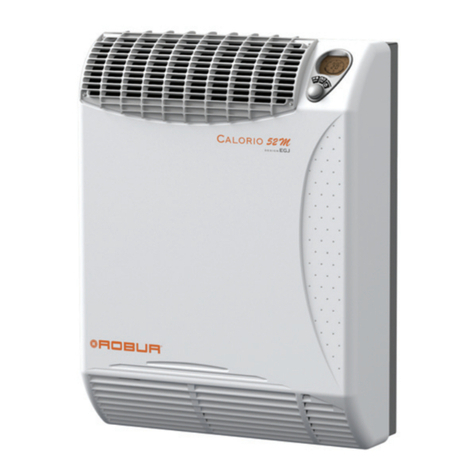
Robur
Robur Calorio M User manual

Robur
Robur 5001 User manual
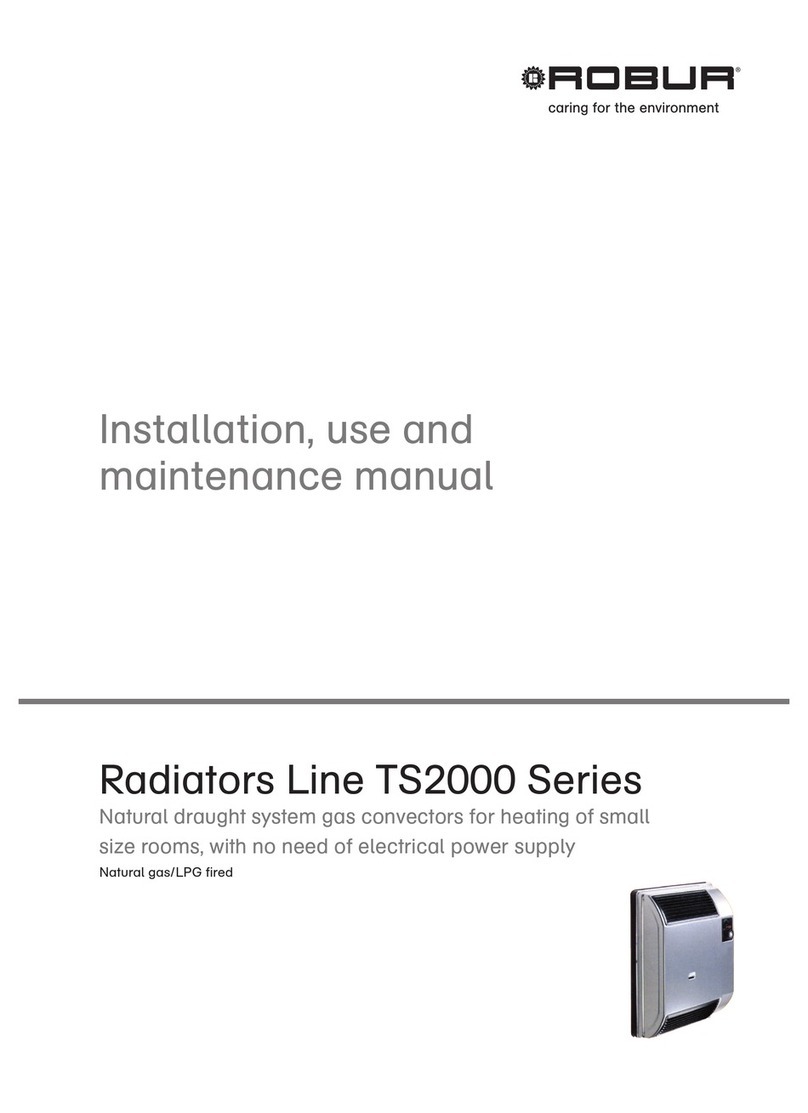
Robur
Robur TS2000 Series User manual
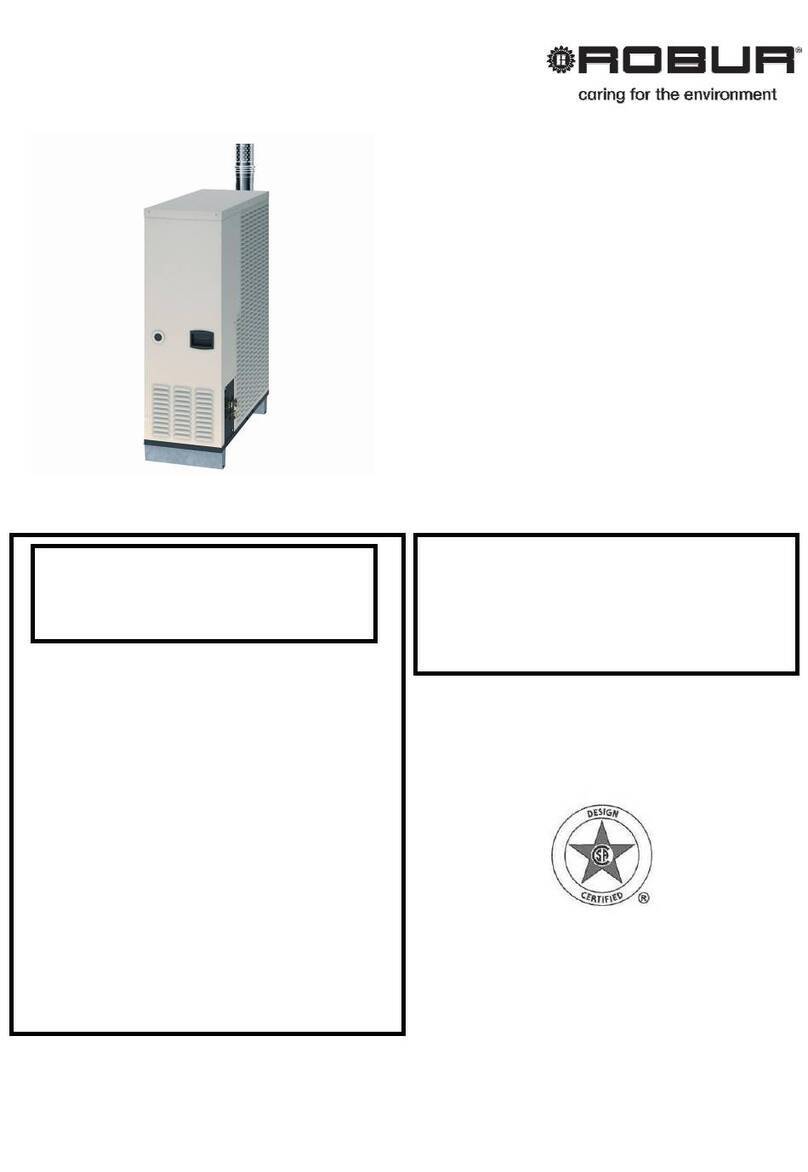
Robur
Robur AY00-119 Series User manual
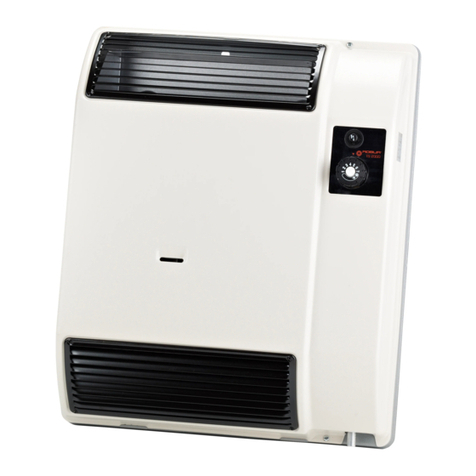
Robur
Robur TS 2000 User manual

Robur
Robur Heaters Line F2 C Series Service manual
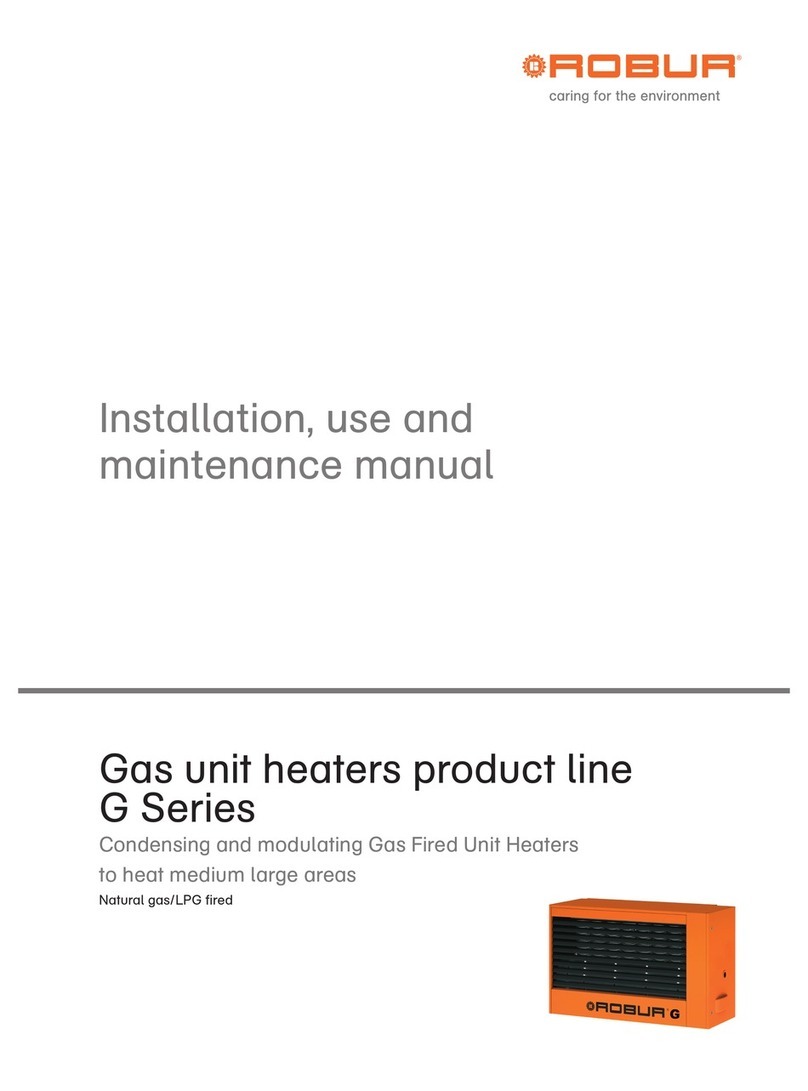
Robur
Robur G 30 Service manual

Robur
Robur Supercromo User manual

Robur
Robur Next-R User manual
Popular Heater manuals by other brands

solamagic
solamagic IR 03001 Installation and instruction manual
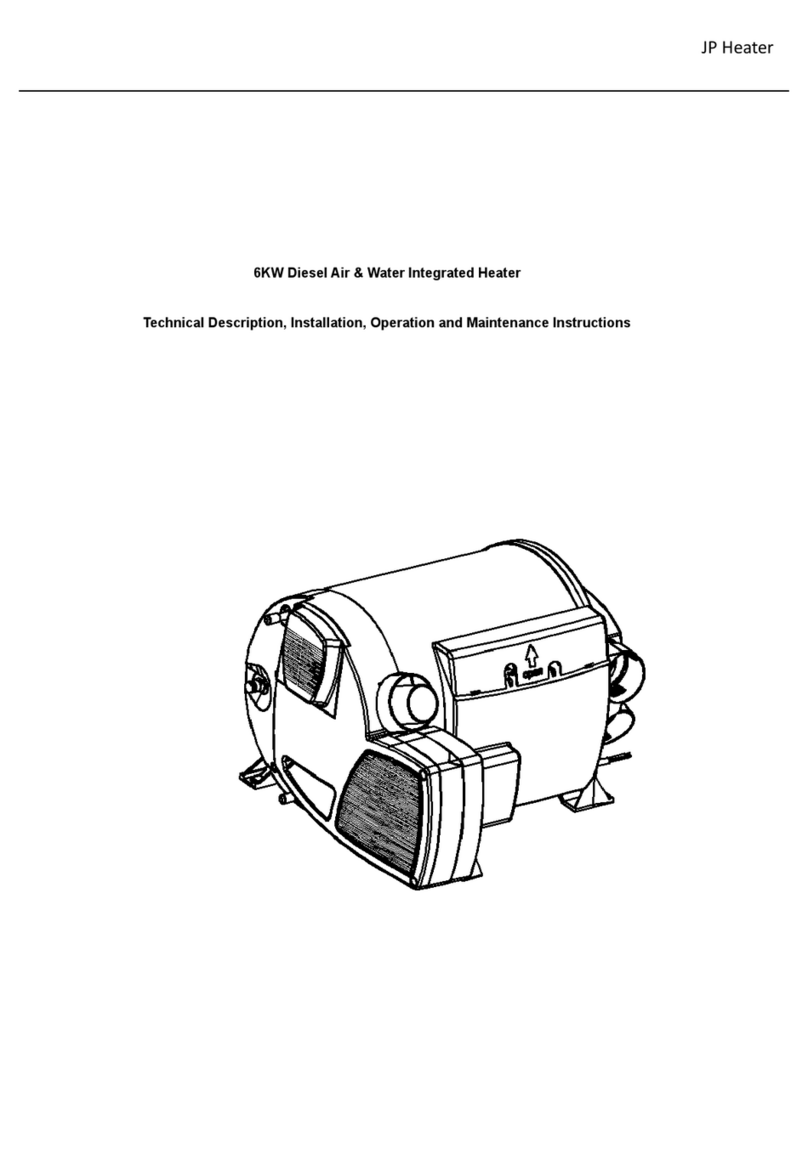
JP
JP FJH-4/1C-E Technical description, installation, operation and maintenance instructions
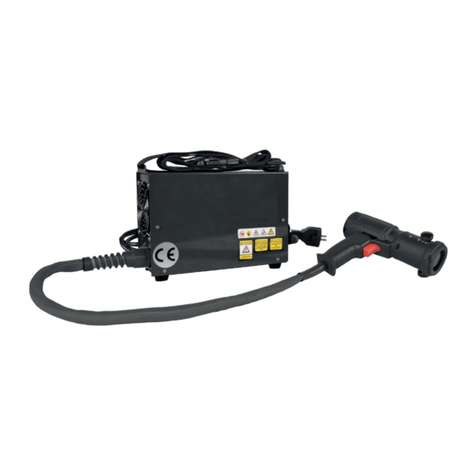
Gson
Gson 400613 user manual
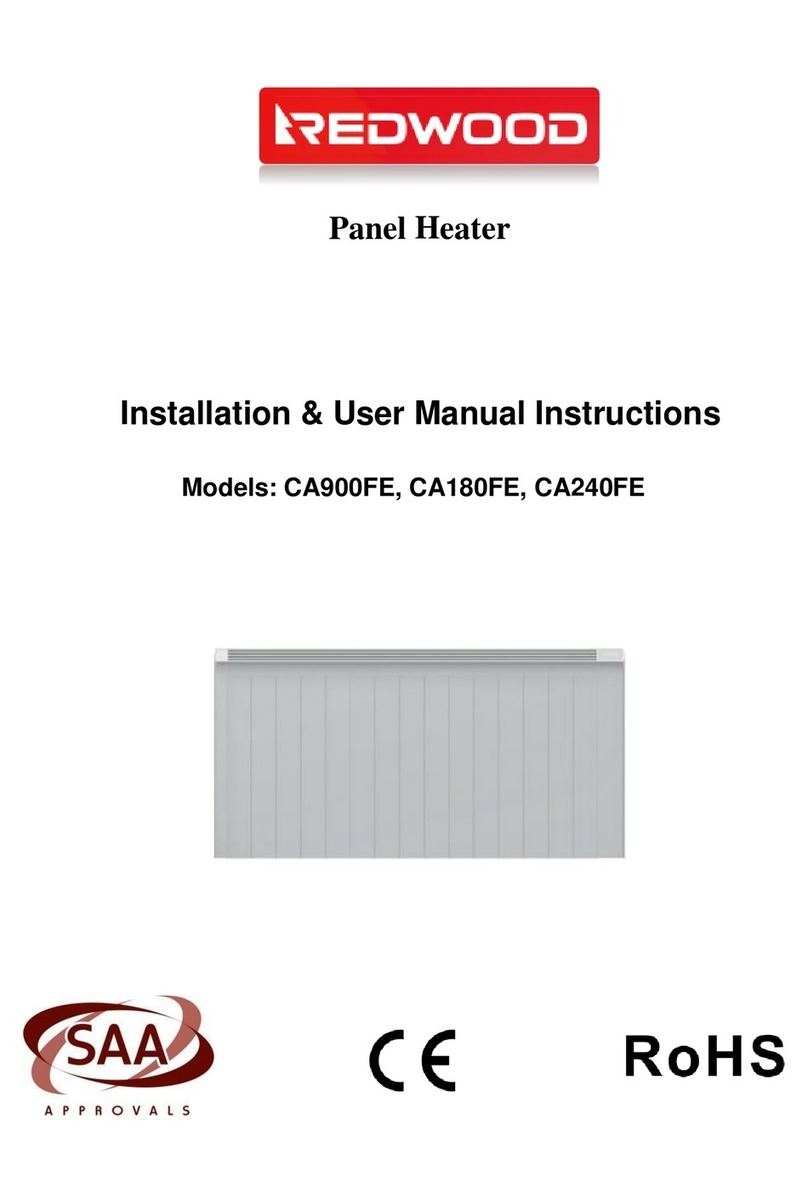
Redwood
Redwood CA900FE Installation & User Manual Instructions

Ambirad
Ambirad Vision Range VSXUS owner's manual

Millar
Millar 58.186 user manual

